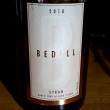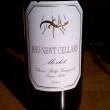A Niagara Without Borders
By Bryan Calandrelli, Niagara Escarpment Editor
The Niagara River is the natural border that divides Western New York and Ontario. When you stand at some points along the river and look west, you can’t help but notice how close we are to our Canadian neighbors. It’s becoming more and more evident that this border will get even closer as Niagara USA wineries look to carry on the momentum of Ontario’s successful wine industry, and in some cases, look to import what makes them so successful.
Perhaps the most obvious evidence that Niagara USA wineries are capitalizing off of Ontario’s achievement is ice wine. Local wineries are seeing a great deal of tourist traffic in search of this decadent dessert wine. As of today, three wineries are growing and producing estate grown ice wines that rival those across the river and they have been extremely well received by the public.
Other local wineries with young vineyards that can’t necessarily let their grapes hang into winter are not letting that stop them from producing quality ice wines though. A commercial winery license, as opposed to a farm winery license, allows them to purchase juice from grapes from Ontario pressed according to the VQA (Vintners Quality Alliance) standard. The average tasting room guest doesn’t seem to mind the non-estate ice wines and it looks like more and more wineries will be buying from across the border.
Does this bother me as a wine geek? Yes and no.
Do I personally want to be pouring ice wine from Ontario in a tasting room? No.
But as far as the average tasting room drinker is concerned, I think that as long as the winery is up front about where the grapes are grown, I don’t think it really matters. I do see it putting more pressure on the producers of estate-grown ice wine to brand their wines as such, and present as much information in the form of photos, videos and stories from their own harvest to compete with the other wines in the market.
Will this trend stop with ice wine? Probably not. There is a huge demand for local Niagara vinifera grapes and not enough local grapes to go around. Many wineries already supplement with Finger Lakes, Chautauqua or Long island grapes, but I’ve heard some buzz that Ontario may become another source.
At first this didn’t sit well with me, although as time went on I realized that if wineries were going to source from outside the county, at least Ontario fruit will resemble what we grow here. The geology and climate are so similar that you’d be hard pressed to identify the origin of two well-made wines in a blind tasting.
The Niagara Escarpment AVA here shares much in common with the Beamsville Bench area of Ontario, as do the Canadian lakeshore sub-appellations with the Niagara County lakeshore of Lake Ontario. I think that winemakers here will benefit from using Canadian grapes as they become accustomed to the similarities in terroir, and more importantly how to showcase it in their wines.
I’ve barely scratched the surface of this topic. I hope to get around to discussing how the current customs laws and border practices affect wine traffic and sales. I want to also tackle how Niagara Ontario’s ever-increasing exposure will affect our corner of New York.
I might even speculate on the importance of Paul Hobbs now consulting for Stratus Winery in Niagara on the Lake. Until then I am satisfied with the thought of the NYCR’s readers trying any Niagara wine, whether it be from New York or Ontario.


















I am the owner of one winery importing fruit for icewine from Canada and I am also the president of the Binational tourism alliance (cross border tourism). I see the region as one region, 2 countries. It is one of the things that makes this an interesting place to visit. Imagine the possibilities for the area if we could label as a region, trade as a region and the region was recognized as one (something that is happening in the minds of some consumers already). Growth would be explosive, quality would soar and things would get even more interesting. . In fact, some of the most popular wines are “bottled in” California - made from imported wine from halfway around the world. Buying grapes, fermenting them, making the wine and aging it using the winery’s unique processes is certainly a valid method. Particularly so when the grapes come from less than 20 miles away, rather than the “acceptable NY source” 450 miles away that Long Island is. It’s the reason there are growers who don’t make wine. I suspect growers acreage rivals winery owned acreage in Ontario, which means most wineries are buying grapes. I am digressing, though.
. In fact, some of the most popular wines are “bottled in” California - made from imported wine from halfway around the world. Buying grapes, fermenting them, making the wine and aging it using the winery’s unique processes is certainly a valid method. Particularly so when the grapes come from less than 20 miles away, rather than the “acceptable NY source” 450 miles away that Long Island is. It’s the reason there are growers who don’t make wine. I suspect growers acreage rivals winery owned acreage in Ontario, which means most wineries are buying grapes. I am digressing, though.
Most wineries in the world do not grow all their own grapes. This is an unrealistic expectation from consumers and I suspect it is fueled by wine bloggers
Regarding the border, I am old enough to remember going across with minimal delay, no ID and very little in the way of questions. At one point gas was significantly less expensive in Canada and it was an easy trip to fill the car’s tank. I can’t imagine getting across that quickly today, which is sad. From a climate, soil and growing perspective, both sides of the border are identical. Someday the border will again be easy to cross and perhaps the wine regions will work closely together to attract visitors from around the world. The NYC to Toronto trip is an attractive one for lots of people today with the undervalued dollar (and the many weeks of vacation that Europeans enjoy).
But… Terroir is supposed to respect borders drawn on maps! Haven’t you seen a map of Burgundy? Every individual postage stamp of land has its own sense of place! How can grapes from across a border possibly be similar?
All kidding aside, I agree. Many producers in the Finger Lakes buy from all over the region, Cayuga, Seneca, Keuka, and Canandaigua and nobody bats an eye because the AVA is “Finger Lakes”. Few are lucky enough to be completely estate and have total control over their grapes.
Thanks for bringing this to light.
Duncan-
You bring up some great points including how crossing the border has changed in recent years. Not only can you expect delays more often than not, but customs restrictions of the amount of wine either citizen can bring across doesn’t help sales. That is an entire post in itself and you’ll be the first person I interview as you obviously are involved in changing things at the border.
Tom
Burgundy is still Burgundy even with all those Grand Cru sites and Premier Cru sites divided up. I think Duncan is saying that Niagara is still Niagara.
Since we are speaking of Burgundy, if there were Grand Cru sites here I think Duncan’s Arrowhead Spring, FRW and Warm Lake Estate would be classified as grand cru sites of the Niagara Escarpment.
It makes just as much sense as the Lake Erie AVA going through NY, PA, and OH. The point is to highlight the geology, the terrior, not political boarders. I think the Canadian and US Niagara should be considered an IVA (International Viticulture Area).
and Tom, I understand you were making a joke, but on a serious note, I definatly believe in terrior, and I have a good enough understanding of geology and soilmaps to know that an individual “plot” can contain multiple soil groups. but the way the French take it to such an extreem it total BS. they only do it because they were stuck with a completely illogical set of inheritance laws from the Napoleonic era.